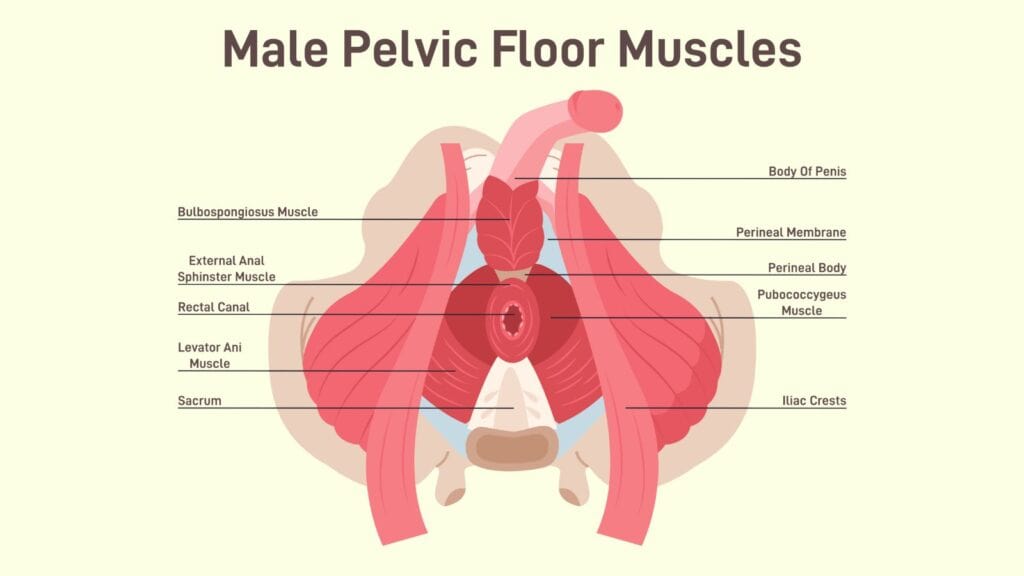Understanding Pelvic Floor Therapy: A Comprehensive Guide
The ailments that frequently necessitate seeking pelvic floor therapy are familiar to a vast majority of individuals. Issues such as painful sex, urinary incontinence, post pregnancy prolapse and persistent lumbar discomfort are commonly encountered concerns prompting visits to medical professionals or physical therapists.
Pelvic Floor Physical Therapy (PFPT) is a specialized form of physical therapy to treat various disorders and dysfunctions related to the pelvic floor muscles. These muscles are crucial in supporting pelvic organs, maintaining urinary and bowel continence, and facilitating sexual function. PFPT involves targeted exercises, manual techniques, and behavioral modifications designed to improve pelvic floor function and alleviate associated symptoms.
Understanding the Pelvic Floor

The pelvic floor refers to a group of muscles located at the base of the pelvis, forming a hammock-like structure that supports the bladder, uterus, and rectum. These muscles contract and relax to control urinary and bowel movements, stabilize the pelvis, and contribute to sexual arousal and orgasm. Dysfunction in the pelvic floor muscles can lead to a range of symptoms, including urinary and fecal incontinence, pelvic pain, and sexual dysfunction.
Importance of Pelvic Floor Health
Maintaining optimal pelvic floor health is essential for overall well-being and quality of life. Dysfunction in this area can significantly impact urinary and bowel function, sexual satisfaction, and mobility. Pelvic floor therapy aims to address these issues by targeting the underlying muscle dysfunction and restoring normal function.
What is Pelvic Floor Therapy?

Pelvic Floor Therapy, also known as pelvic floor rehabilitation or pelvic physiotherapy, is a non-invasive approach to treating pelvic floor dysfunction. It involves a combination of exercises, manual techniques, and lifestyle modifications tailored to each individual’s needs. The primary goals of pelvic floor therapy are to strengthen weak muscles, release tension in overactive muscles, improve muscle coordination, and enhance awareness of pelvic floor function.
Conditions Treated
Pelvic floor therapy can effectively treat a variety of conditions, including urinary incontinence, fecal incontinence, pelvic organ prolapse, pelvic pain syndromes, and sexual dysfunction. It is commonly recommended for individuals experiencing symptoms such as frequent urination, urgency, urinary leakage, pain during intercourse, or difficulty emptying the bladder or bowel.
Techniques Used
Therapists employ a range of techniques to address pelvic floor dysfunction, including Kegel exercises, biofeedback training, manual therapy, and relaxation techniques. Kegel exercises involve contracting and relaxing the pelvic floor muscles to improve strength and coordination. Biofeedback utilizes sensors to provide real-time feedback on muscle activity, helping individuals learn to control and coordinate their pelvic floor muscles more effectively. There is
Benefits of Pelvic Floor Therapy

Pelvic floor therapy offers numerous benefits, including improved bladder and bowel control, reduced pelvic pain, enhanced sexual function, and increased quality of life. By addressing underlying muscle dysfunction and promoting better pelvic floor function, individuals can experience significant symptom relief and improved overall well-being.
Who Can Benefit from Pelvic Floor Therapy?
Pelvic floor therapy is beneficial for individuals of all ages and genders who are experiencing pelvic floor dysfunction. This includes women, men, pregnant individuals, and postpartum women. Whether dealing with urinary incontinence, pelvic pain, or sexual dysfunction, pelvic floor therapy can help restore normal function and alleviate associated symptoms.
How to Prepare for Pelvic Floor Therapy
Before starting pelvic floor therapy, it is essential to schedule a consultation with a qualified healthcare provider, such as a pelvic floor physical therapist or urologist. During this consultation, the provider will assess your symptoms, medical history, and pelvic floor function to determine the most appropriate treatment approach. It is also essential to set realistic expectations and commit to following the recommended treatment plan.
What to Expect During Pelvic Floor Therapy Sessions
Pelvic floor therapy typically begins with an initial assessment, during which the therapist will evaluate your pelvic floor function, muscle strength, and range of motion. Based on this assessment, a personalized treatment plan will be developed, which may include a combination of therapeutic exercises, manual techniques, and lifestyle modifications. Subsequent therapy sessions will focus on practicing these exercises and techniques under the guidance of the therapist.
Duration and Frequency of Pelvic Floor Therapy
The duration and frequency of pelvic floor therapy will vary depending on the individual’s condition, severity of symptoms, and response to treatment. In general, therapy sessions may be scheduled once or twice per week and may last for several weeks to several months. Consistency and adherence to the treatment plan are essential for achieving optimal results.
Potential Risks and Side Effects
Pelvic floor therapy is generally safe and well-tolerated, but like any form of therapy, it may carry some risks and side effects. These may include temporary discomfort or soreness, increased urinary frequency or urgency, or aggravation of existing symptoms. It is essential to communicate openly with your therapist about any concerns or adverse effects you experience during treatment.
Pelvic Floor Therapy vs. Surgical Intervention
Pelvic floor therapy is often considered a first-line treatment for pelvic floor dysfunction, as it is non-invasive and carries fewer risks than surgical intervention. While surgery may be necessary in some cases, many individuals can achieve symptom relief and improved pelvic floor function through conservative therapies such as pelvic floor therapy. Your healthcare provider can help determine the most appropriate treatment approach based on your specific needs and circumstances.
Maintenance of Pelvic Floor Health: Embodiment Through Somatic Movement
Our holistic well-being is intricately linked to your pelvic floor health, with your entire body playing a significant role in addressing specific issues. Completing pelvic floor therapy exercises marks only a step in the journey, as there is further potential to exert control over your condition.
Pelvic floor concerns may actually originate above the pelvic floor from imbalances in your hips, ribs jaw or below from your feet. The entire body is connected via a web-like “cat suit” called fascia. Disruptions in the fascia due to faulty movements, injury or even compensatory habits can inhibit pelvic floor healing.
Embodiment through Somatic Movement introduces a groundbreaking approach to enhancing functionality, mental well-being, and emotional equilibrium, reshaping conventional perspectives on bodily awareness. This innovative paradigm emphasizes living within one’s body with heightened mindfulness and improved mobility, promoting structural integrity and overall ease.
Somatic movement also addresses the fear, fight and flight many feel when there are uncomfortable pelvic floor symptoms. It’s easy to get stressed about difficulties, but unfortunately, the bodily reactions of stress can put more pressure on the pelvic floor.
Individuals who engage in this practice often express astonishment at the profound connection between the entire body and the pelvic floor.
Embodiment serves as a transformative practice akin to meditation for the mind, fostering a profound understanding and connection with the body’s intricate mechanisms and sensations. Learn more at Original Body Wisdom.
Watch Donna Brooks of Original Body Wisdom: True Diaphragmatic Breathing For Pelvic Floor Health
Success Rate of Pelvic Floor Therapy
The success rate of pelvic floor therapy varies depending on the individual’s condition, adherence to the treatment plan, and other factors. However, research has shown that pelvic floor therapy can be highly effective in alleviating symptoms and improving pelvic floor function in many cases. With commitment and consistency, individuals can achieve significant improvements in bladder and bowel control, pelvic pain, and sexual function.

You may want to read: Somatic Movement Therapy: Unlocking The Body-Mind Connection
Conclusion
Pelvic floor therapy is a valuable treatment option for individuals experiencing pelvic floor dysfunction, including urinary and fecal incontinence, pelvic pain, and sexual dysfunction. By targeting the underlying muscle dysfunction and promoting better pelvic floor function, therapy can provide significant symptom relief and improve overall quality of life. With the guidance of a qualified healthcare provider, individuals can learn strengthen weak muscles, release tension in overactive muscles, and regain control over bladder and bowel function.
FAQs
- Is pelvic floor therapy only for women? No, pelvic floor therapy is beneficial for individuals of all genders who are experiencing pelvic floor dysfunction.
- How long does it take to see results from pelvic floor therapy? The timeline for seeing results from pelvic floor therapy varies depending on the individual’s condition and response to treatment. Some individuals may experience improvement in symptoms within a few weeks, while others may require more time.
- Are there any exercises I can do at home to complement pelvic floor therapy? Yes, your therapist may recommend specific exercises to perform at home between therapy sessions to enhance the effectiveness of treatment.
- Are there any risks associated with pelvic floor therapy? While pelvic floor therapy is generally safe, some individuals may experience temporary discomfort or other side effects. It is essential to communicate any concerns with your therapist.
- How often should I attend pelvic floor therapy sessions? The frequency of pelvic floor therapy sessions will depend on your individual needs and treatment plan. Your therapist will recommend a schedule based on your condition and response to treatment.








